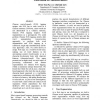Free Online Productivity Tools
i2Speak
i2Symbol
i2OCR
iTex2Img
iWeb2Print
iWeb2Shot
i2Type
iPdf2Split
iPdf2Merge
i2Bopomofo
i2Arabic
i2Style
i2Image
i2PDF
iLatex2Rtf
Sci2ools
EMNLP
2004
2004
Chinese Part-of-Speech Tagging: One-at-a-Time or All-at-Once? Word-Based or Character-Based?
Chinese part-of-speech (POS) tagging assigns one POS tag to each word in a Chinese sentence. However, since words are not demarcated in a Chinese sentence, Chinese POS tagging requires word segmentation as a prerequisite. We could perform Chinese POS tagging strictly after word segmentation (one-at-a-time approach), or perform both word segmentation and POS tagging in a combined, single step simultaneously (all-atonce approach). Also, we could choose to assign POS tags on a word-by-word basis, making use of word features in the surrounding context (word-based), or on a character-by-character basis with character features (character-based). This paper presents an in-depth study on such issues of processing architecture and feature representation for Chinese POS tagging, within a maximum entropy framework. We found that while the all-at-once, characterbased approach is the best, the one-at-a-time, character-based approach is a worthwhile compromise, performing only slightly worse in ter...
Chinese POS | EMNLP 2004 | EMNLP 2007 | POS Tags | Word Segmentation |
| Added | 30 Oct 2010 |
| Updated | 30 Oct 2010 |
| Type | Conference |
| Year | 2004 |
| Where | EMNLP |
| Authors | Hwee Tou Ng, Jin Kiat Low |
Comments (0)

